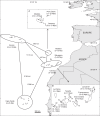Phylogeography and seed dispersal in islands: the case of Rumex bucephalophorus subsp. canariensis (Polygonaceae)
- PMID: 23267005
- PMCID: PMC3555536
- DOI: 10.1093/aob/mcs284
Phylogeography and seed dispersal in islands: the case of Rumex bucephalophorus subsp. canariensis (Polygonaceae)
Abstract
Background and aims: Rumex bucephalophorus subsp. canariensis is an endemic taxon to Macaronesia with diaspore polymorphism. The origin and colonizing route of this taxon in Macaronesia was studied using molecular data and information on diaspore types.
Methods: Amplified fragment length polymorphism (AFLP) was used in 260 plants from 22 populations of R. bucephalophorus subsp. canariensis, four from the Madeiran archipelago and 18 from the Canary archipelago. Diaspore production was analysed in 9-50 plants from each population used for AFLP analysis. One hundred and one plants from the Madeiran archipelago and 375 plants from the Canary Islands were studied. For each plant the type of diaspore produced was recorded.
Key results: Overall populations had low genetic diversity but they showed a geographical pattern of genetic diversity that was higher in the older eastern islands than in the younger western ones. Two types of dispersible diaspores were found: in the eastern Canary islands (Lanzarote, Fuerteventura and Gran Canaria), plants produced exclusively long-dispersible diaspores, whereas in the western Canary islands (Tenerife, La Gomera, El Hierro) and the Madeiran archipelago plants produced exclusively short-dispersible diaspores. Genetically, the studied populations fell into four main island groups: Lanzarote-Fuerteventura, Gran Canaria, Tenerife-El Hierro and La Gomera-Madeira archipelago.
Conclusions: A Moroccan origin of R. bucephalophorus subsp. canariensis is hypothesized with a colonization route from the eastern to the western islands. In addition, at least one gene flow event from La Gomera to the Madeiran archipelago has taken place. During the colonization process the type of dispersible diaspore changed so that dispersability decreased in populations of the westernmost islands.
Figures


Similar articles
-
Molecular phylogeny and systematics of the highly polymorphic Rumex bucephalophorus complex (Polygonaceae).Mol Phylogenet Evol. 2011 Dec;61(3):659-70. doi: 10.1016/j.ympev.2011.08.005. Epub 2011 Aug 16. Mol Phylogenet Evol. 2011. PMID: 21864695
-
Molecular phylogenetics of Micromeria (Lamiaceae) in the Canary Islands, diversification and inter-island colonization patterns inferred from nuclear genes.Mol Phylogenet Evol. 2015 Aug;89:160-70. doi: 10.1016/j.ympev.2015.04.017. Epub 2015 Apr 30. Mol Phylogenet Evol. 2015. PMID: 25937559
-
Population Structure, Genetic Diversity, and Evolutionary History of Kleinia neriifolia (Asteraceae) on the Canary Islands.Front Plant Sci. 2017 Jun 30;8:1180. doi: 10.3389/fpls.2017.01180. eCollection 2017. Front Plant Sci. 2017. PMID: 28713419 Free PMC article.
-
Divergence times and colonization of the Canary Islands by Gallotia lizards.Mol Phylogenet Evol. 2010 Aug;56(2):747-57. doi: 10.1016/j.ympev.2010.03.020. Epub 2010 Mar 20. Mol Phylogenet Evol. 2010. PMID: 20307675
-
Morphology, Behaviour and Evolution of Gallotia Lizards from the Canary Islands.Animals (Basel). 2023 Jul 15;13(14):2319. doi: 10.3390/ani13142319. Animals (Basel). 2023. PMID: 37508096 Free PMC article. Review.
Cited by
-
Peripatric speciation in an endemic Macaronesian plant after recent divergence from a widespread relative.PLoS One. 2017 Jun 2;12(6):e0178459. doi: 10.1371/journal.pone.0178459. eCollection 2017. PLoS One. 2017. PMID: 28575081 Free PMC article.
-
Diversity hotspots of the laurel forest on Tenerife, Canary Islands: a phylogeographic study of Laurus and Ixanthus.Ann Bot. 2016 Sep;118(3):495-510. doi: 10.1093/aob/mcw124. Epub 2016 Jul 6. Ann Bot. 2016. PMID: 27390352 Free PMC article.
References
-
- Allan GJ, Francisco-Ortega J, Santos-Guerra A, Boerner E, Zimmer EA. Molecular phylogenetic evidence for the geographic origin and classification of Canary Island Lotus (Fabaceae: Loteae) Molecular Phylogenetics and Evolution. 2004;32:123–138. - PubMed
-
- Andersen H. Research on islands: classic, recent and prospective approaches. In: Vitousek PM, Loope LL, Adsersen H, editors. Berlin: Springer: Islands: biological diversity and ecosystem function; 1995. pp. 7–21.
-
- Balao F, Valente LM, Vargas P, Herrera J, Talavera S. Radiative evolution of polyploid races of the Iberian carnation Dianthus broteri (Caryophyllaceae) New Phytologist. 2010;187:542–551. - PubMed
-
- Baldwin BG, Crawford DJ, Francisco-Ortega J, Kim S-C, Sang T, Stuessy TF. Molecular phylogenetics insights on the origin and evolution of oceanic island plants. In: Soltis DE, Soltis PS, Doyle JJ, editors. New York: Kluwer: Molecular systematics of plants, II: ADN sequencing; 1998. pp. 410–441.
-
- Barber JC, Francisco-Ortega J, Santos-Guerra A, Turner KG, Jansen RK. Origin of Macaronesian Sideritis L. (Lamioideae: Lamiaceae) inferred from nuclear and chloroplast sequence datasets. Molecular Phylogenetics and Evolution. 2002;23:293–306. - PubMed

